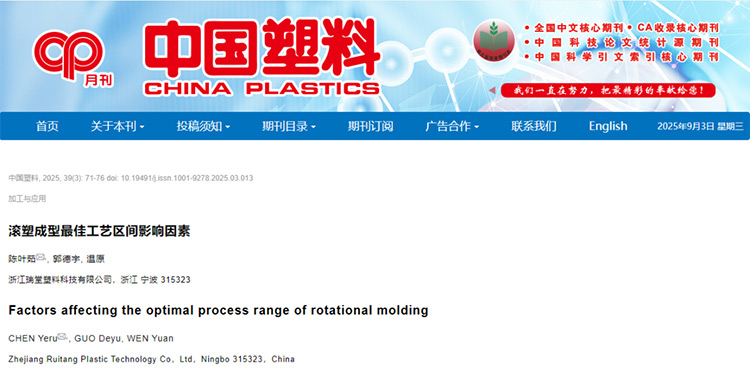
- English
- Español
- Português
- русский
- Français
- 日本語
- Deutsch
- tiếng Việt
- Italiano
- Nederlands
- ภาษาไทย
- Polski
- 한국어
- Svenska
- magyar
- Malay
- বাংলা ভাষার
- Dansk
- Suomi
- हिन्दी
- Pilipino
- Türkçe
- Gaeilge
- العربية
- Indonesia
- Norsk
- تمل
- český
- ελληνικά
- український
- Javanese
- فارسی
- தமிழ்
- తెలుగు
- नेपाली
- Burmese
- български
- ລາວ
- Latine
- Қазақша
- Euskal
- Azərbaycan
- Slovenský jazyk
- Македонски
- Lietuvos
- Eesti Keel
- Română
- Slovenski
- मराठी
- Srpski језик
Company News: We are delighted to announce that our company's paper "Influencing Factors of the Optimal Process Range for Rotational Molding" has been mentioned and received attention in the magazine "China Plastics"
Linear low-density polyethylene (PE-LLD) was selected as the base material. The melt blending was carried out by a twin-screw extruder, and the powder material suitable for rotational molding process was prepared by using a mechanical grinding mill. The thickness of rotational molding products is controlled by regulating the amount of feed. Five factors, namely the thickness of rotational molding products, the melt flow rate (MFR) of rotational molding materials, the particle size distribution of powder, the addition amount of carbon black, and the furnace temperature of rotational molding equipment, were deeply discussed for the minimum PIAT (PIAT P) required to eliminate the pores in the product wall during the rotational molding process, and the minimum PIAT (PIAT I) required to be achieved when the yellowing index of the inner surface of the product is zero A systematic analysis was conducted on the combined effects of the optimal rotational molding process range (BPI) and the low-temperature drop hammer impact strength (LTIS) within this range. The results show that with the increase of the thickness of rotational molding products and the improvement of MFR, the temperature for eliminating pores drops significantly. Meanwhile, the BPI of rotational molding is significantly broadened, and the thickness increases while the LTIS improves. The reduction of the particle size of the powder leads to an increase in PIAT P and a decrease in PIAT I, and the range of rotational molding BPI is correspondingly narrowed. The influence of the addition amount of carbon black on the range of PIAT P, PIAT I and BPI is relatively small. Meanwhile, with the increase of the addition amount of carbon black, the matrix LTIS slightly increases. Increasing the furnace temperature of rotational molding equipment will cause PIAT P to increase slowly and PIAT I to increase significantly, thereby expanding the range of rotational molding BPI.




